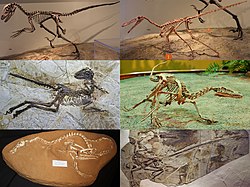
Back Dromaeosauridae Afrikaans درومايوصوريات Arabic Dromeozavridlər Azerbaijani Dromeosàurids Catalan Dromaeosauridae CEB Dromaeosauridae Czech Dromaeosauridae Danish Dromaeosauridae German Dromeosaŭredoj Esperanto Dromaeosauridae Spanish
| Dromaeosaurids Temporal range:
| |
|---|---|

| |
| A collection of dromaeosaurid fossil skeletons. Clockwise from upper left: Deinonychus antirrhopus (a heavily built eudromaeosaur), Buitreraptor gonzalezorum (a long-snouted unenlagiine), Velociraptor mongoliensis (a small velociraptorine), Microraptor gui (a winged microraptorian), Halszkaraptor escuilliei (a semiaquatic halszkaraptorine), Zhenyuanlong suni (a long-winged dromaeosaurid) | |
| Scientific classification | |
| Domain: | Eukaryota |
| Kingdom: | Animalia |
| Phylum: | Chordata |
| Clade: | Dinosauria |
| Clade: | Saurischia |
| Clade: | Theropoda |
| Clade: | Paraves |
| Family: | †Dromaeosauridae Matthew & Brown, 1922 |
| Type species | |
| †Dromaeosaurus albertensis Matthew & Brown, 1922
| |
| Subgroups[5] | |
| |
| Synonyms | |
| |
Dromaeosauridae (/ˌdrɒmi.əˈsɔːrɪdiː/) is a family of feathered coelurosaurian theropod dinosaurs. They were generally small to medium-sized feathered carnivores that flourished in the Cretaceous Period. The name Dromaeosauridae means 'running lizards', from Greek δρομαῖος (dromaîos), meaning 'running at full speed', 'swift', and σαῦρος (saûros), meaning 'lizard'. In informal usage, they are often called raptors[6] (after Velociraptor), a term popularized by the film Jurassic Park; several genera include the term "raptor" directly in their name, and popular culture has come to emphasize their bird-like appearance and speculated bird-like behavior.
Dromaeosaurid fossils have been found across the globe in North America, Europe, Africa, Asia and South America, with some fossils giving credence to the possibility that they inhabited Australia as well.[7] The earliest body fossils are known from the Early Cretaceous (145–140 million years ago), and they survived until the end of the Cretaceous (Maastrichtian stage, 66 ma), existing until the Cretaceous–Paleogene extinction event. The presence of dromaeosaurids as early as the Middle Jurassic has been suggested by the discovery of isolated fossil teeth, though no dromaeosaurid body fossils have been found from this period.[8][9]
- ^ Hartman, Scott; Mortimer, Mickey; Wahl, William R.; Lomax, Dean R.; Lippincott, Jessica; Lovelace, David M. (2019-07-10). "A new paravian dinosaur from the Late Jurassic of North America supports a late acquisition of avian flight". PeerJ. 7: e7247. doi:10.7717/peerj.7247. ISSN 2167-8359. PMC 6626525. PMID 31333906.
- ^ Porfiri, Juan D.; Baiano, Mattia A.; dos Santos, Domenica D.; Gianechini, Federico A.; Pittman, Michael; Lamanna, Matthew C. (2024-06-14). "Diuqin lechiguanae gen. et sp. nov., a new unenlagiine (Theropoda: Paraves) from the Bajo de la Carpa Formation (Neuquén Group, Upper Cretaceous) of Neuquén Province, Patagonia, Argentina". BMC Ecology and Evolution. 24 (1): 77. Bibcode:2024BMCEE..24...77P. doi:10.1186/s12862-024-02247-w. ISSN 2730-7182. PMC 11177497. PMID 38872101.
- ^ Allain, Ronan; Pereda-Suberbiola, Xabier (2003). "Dinosaurs of France". Comptes Rendus Palevol. 2 (1): 27–44. Bibcode:2003CRPal...2...27A. doi:10.1016/S1631-0683(03)00002-2.
- ^ Agnolin, Federico L.; Motta, Matias J.; Brissón Egli, Federico; Lo Coco, Gastón; Novas, Fernando E. (2019-02-12). "Paravian Phylogeny and the Dinosaur-Bird Transition: An Overview". Frontiers in Earth Science. 6. doi:10.3389/feart.2018.00252. hdl:11336/130197. ISSN 2296-6463.
- ^ Holtz, Thomas R. Jr. (2012) Dinosaurs: The Most Complete, Up-to-Date Encyclopedia for Dinosaur Lovers of All Ages, Winter 2011 Appendix.
- ^ Acorn, J. (2007). Deep Alberta: Fossil Facts and Dinosaur Digs. University of Alberta Press. pp. 13. doi:10.1515/9780888648518. ISBN 978-0-88864-481-7.
- ^ Barrett, Paul M.; Benson, Roger B. J.; Rich, Thomas H.; Vickers-Rich, Patricia (23 December 2011). "First spinosaurid dinosaur from Australia and the cosmopolitanism of Cretaceous dinosaur faunas". Biology Letters. 7 (6): 933–936. doi:10.1098/rsbl.2011.0466. PMC 3210678. PMID 21693488.
- ^ Metcalf, S.J.; Vaughan, R.F.; Benton, M.J.; Cole, J.; Simms, M.J.; Dartnall, D.L. (January 1992). "A new Bathonian (Middle Jurassic) microvertebrate site, within the Chipping Norton Limestone Formation at Hornsleasow Quarry, Gloucestershire". Proceedings of the Geologists' Association. 103 (4): 321–342. Bibcode:1992PrGA..103..321M. doi:10.1016/S0016-7878(08)80129-0.
- ^ Wills, S.; Underwood, C. J.; Barrett, P. M. (2023). "Machine learning confirms new records of maniraptoran theropods in Middle Jurassic UK microvertebrate faunas". Papers in Palaeontology. 9 (2). e1487. Bibcode:2023PPal....9E1487W. doi:10.1002/spp2.1487.